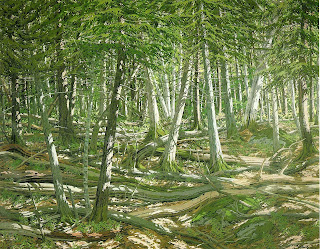 |
| "Old Windfall" by Neil Welliver |
A reader writes: "When I look out at the world it seems complex. How do I simplify it in a painting without losing touch with its complexity?"
I often find my eye pulled toward the natural world's wonderful complexity. There's something infinitely pleasing about, for example, the baroque intricacy of a woodlot. Tangled brambles, interlocked branches, and the play of little spots of light and shadow form a visual playground.
But as attractive as such a scene is, is it a suitable subject for a painting? Well, that depends on your goal. If your goal is to convey the complexity, then yes. But with what method and materials will you accomplish your task? In my mind, you will be working with many, many small shapes. If you flatten the scene to analyze it - that is, if you close one eye to eliminate the third dimension and then squint to simply and consider the scene as a collection of shapes - you'll see an infinitude of tiny polygons. The precise relationship of each polygon to its neighbor is crucial to creating the sense of overlapping vines and limbs.
This kind of precision means drawing. So, I would consider a drawing medium such as pencil, charcoal or pastel to be an obvious choice. But what about paint? You can use that, too, but it's still going to require careful drawing.
Of course, you will still have to initially simplify the scene. You'll need to take infinity and break it down to a handful of large, simple shapes. Again, if you squint, you can simplify the scene and see these big shapes. With a particularly dense woodlot, you may have mostly dark big shapes and a few tiny light shapes. (Light has a hard time penetrating a thick stand of trees.) Start with that, and then open your eyes slowly and begin to break the big shapes down into smaller ones.
All that said, this task is almost impossible to accomplish in a plein air painting. In a dense woodlot, the passage of the sun seems to have a greater impact than it does in, say, an open field. Those little spots of light seem to move along the branches much faster that you'd expect. You are better off doing a quick color sketch to get the color notes, a value sketch to get a handle on values, and then take photos for all the details. Then, head for the studio where you can work on recreating the complexity at your leisure.
Personally, I find this kind of complexity enchanting, but I don't have the stamina for it. But some painters excelled at this kind of thing - the Maine painter Neil Welliver comes to mind. At the top of this post, you can see and example of his work. It would be a good exercise to look at "Old Windfall" and see, if you were to recreate this scene on your own, how you would start to simplify it.
